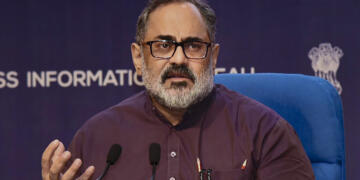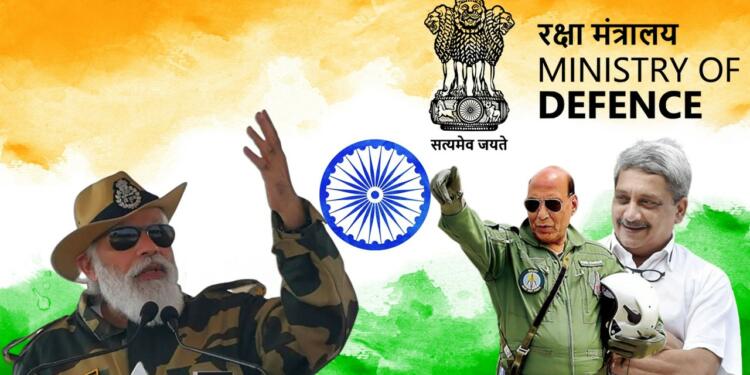Being nonchalantly aggressive was a trademark of PM Modi’s election campaign. He never apologised for any of the allegations peddled towards him. When he became the PM, people expected the same aggression in political orders to the Defence Forces. Soon, the Ministry of Defence became a key focus of PM Modi’s cabinet. Respective Defence Ministers put in meticulous efforts to make Defence set up the face of new India. Let’s have a look at big-ticket changes.
Made in India defence products
When the Modi government took the oath, India was the second biggest defence importer in the world. It puts a huge burden on our defence budget. Additionally, this could prove to be dangerous in the wake of a crisis as anytime our defence needs could be choked. The Modi government decided to make defence manufacturing a strictly internal affair.
Defence manufacturing became a key focus of make-in-India and Aatmanirbhar Bharat. India is making indigenous defence products under 3 categories, namely, Make-I, Make-II and Make-III.
Projects falling under the Make-I category have the Union government as their funding source. The government provides 90 per cent of the funds required for this category. Currently, 7 projects are in various stages of development under Make-I. 4 of them named Indian Light Tanks, Terminal End Secrecy Device (TESD), Tactical Communication System (TCS), and Futuristic Infantry Combat Vehicle (FICV) will benefit the Army. 3 projects namely Airborne Electro-Optical Pod with Ground-Based System, Airborne Stand-Off Jammer, and Communication System will increase the security apparatus of the Air Force.
Read more: Tata will be developing fighter jets for the Indian Air Force
Under the Make-II category, the industry is the biggest source of funding. Make-II projects can be termed as key pillars of the make-in-India initiative. These are mainly designed to reduce India’s defence imports and are funded by the newly emerging domestic manufacturing industry. Projects under this particular category deal with the manufacturing of prototypes, systems, and subsystems such as spare parts, radar systems, detection systems, instrumentation parts, and light trucks. Currently, 68 such projects for all three Arms of our Forces are in operational stages.
Given the fact that it takes 10 to 15 years for an industry to get to the stage of maturity, the government has decided to take foreign companies on board as well. Projects falling under the Make-III category provide for that. Under it, an Indian vendor can form a joint venture with a foreign Original Equipment Manufacturer to manufacture arms in India.
To eliminate the problem of any hurdle in the defence projects, the government has decided to set up separate defence corridors. Up until now, a total of 568 licences for operating in these corridors have been provided to 351 companies. The target is to get a total turnover of Rs 1.75 lakh crore in local defence and aerospace goods by the end of 2024. The Ministry of Defence is speeding up the process of achieving this goal.
Read more: N Ram, the habitual offender of journalism gets called out by Ministry of Defence
Loosened bureaucratic control in Defence
Bureaucracy has been termed as the biggest hurdle in India’s development. No one thought that it would slowly eat up the defence sector as well. But, it did and the 3-decade long delay in the Tejas project is the ultimate proof of it. A few years back, our government used to spend Rs 1.25 lakh on an average employee of the defence industry. Most of them were from Defence Public Sector Units (DPSU). Additionally, defence agents pitching for foreign OEMs also used to eat large chunks of resources.
Government’s first big anti-bureaucracy intervention was streamlining the regulations related to agents. Recognising the significance of agents in defence procurements, the government allowed the companies to hire agents but imposed some strict conditions on them.

Read more: PM Modi’s war on middlemen
Similarly, earlier defence deals were subject to approval by Babus of the Ministries. No matter the level of their expertise, they could not be as expert as a General. So, giving them higher authority in defence deals than Generals was a bad idea. Through the creation of the post of Chief of Defence Staff, the Ministry of Defence upgraded Military involvement in defence deals.
But, sidelining top bureaucrats is not enough. Bureaucracy is a phenomenon which has permeated the daily routine of every public sector unit. But the lacklustre attitude is unforgivable in Defence as it directly impacts the sovereignty of our civilisational state. The Ministry of Defence decided to do away with the phenomenon. It started its offence with the dissolution of the Ordnance Factory Board (OFB). OFB was restructured into 7 new efficient companies.
Read more: The restructuring of the Ordnance Factory Board will turn India into a defence powerhouse
Breaking OFB became easy because the Ministry had data about its negative impact. Indian Army, in its internal assessment, has found that poor quality defence equipment supplied by Ordnance Factories Board (OFB), had led to 27 deaths and a loss of 960 crore rupees to the government since 2014. Similar data is being collected to overhaul other DPSUs like DRDO, HAL, BDL, and BEML among others.
Public-Private Partnership
Previous governments have been sceptical about the involvement of the public sector in defence enterprises. The socialist tilt of our polity had imposed an aura of distrust among them. They believed that private companies running on profit motive would not be able to serve patriotic purposes. That may be true during the Cold War days, but it was no longer much relevant in the 21st century.
The Ministry of Defence brought in a slew of measures to invite private partnerships. Government formulated the ‘Defence Production and Export Promotion Policy 2020’ to provide impetus to self-reliance in defence manufacturing. Through the ‘Buy (Global-Manufacture in India)’ category it asked foreign vendors to manufacture in India with its local subsidiaries. The Ministry also increased the limit for FDI in the sector. It opened a portal for DPSUs to interact with local MSMEs/Startups looking to participate in local defence manufacturing.
The results were tremendous, to say the least. India, which was known as a net importer of defence items, started to export. Since 2014, Indian Arms export witnessed 6 times growth.
Synergy among top brass of Defence establishment
For most of their co-existences, all three main branches of our Defence establishment have coordinated. However, things get complicated during the war and other emergencies. In these situations, a single figure at the top is needed for faster implementation of orders. That is why Kargil Review Committee suggested the Indian Government to create a military advisor whose directions would be followed by everyone.
The recommendations were followed by the Ministry of Defence of the Modi government. Late General Bipin Rawat became India’s first Chief of Defence Staff (CDS). India’s CDS is the head of the newly formed Department of Military Affairs (DMA) and the chief military adviser to the Ministry. The formation of DMA and CDS posts is considered as a part of developing an Integrated Theatre Command (ITC).
Currently, the Indian Armed Forces have 17 different commands, headed by 4-star officers. Similarly, two existing tri-services theatre commands look after strategic interest in close proximity and nuclear assets respectively. But to synergise existing commands and create a single commander for three services, an ITC is required. Commander of ITC will have all the resources at his disposal strengthening cohesion in the Defence establishment.
Modernisation of Armed Forces
In the wake of ever aggressive anti-India neighbours, the modernisation of the Armed Forces should have been the topmost priority for governments. Unfortunately, for most of the time, the issue remained on the backburner. When Late Shri Manohar Parrikar was taking charge as Defence Minister, the Forces were deficient in basic items like upgraded guns, efficient bulletproof jackets, and quality shoes among others.
The Ministry of Defence changed things within a span of a few years. As of this year’s Republic Day, 93 modernisation projects were at various stages of development. The total value of these products is estimated to be Rs 1.37 lakh crores. The army is procuring high-volume firepower, artillery guns, enhanced Pinaka rocket regiments, longer-range BrahMos supersonic cruise missiles as well as loiter munition systems, runway-independent remotely piloted aircraft systems, and enhanced surveillance and weapon-locating capabilities.
Similarly, the modernisation of the Navy also went up by several notches during the Modi government. When it became crystal clear that not just in Galwan valley, India and China will be naval rivals as well, our Navy stepped up with the launch of an Aircraft Carrier, large warships, submarines and maritime aircraft. During the initial days of the Make in India initiative, the Indian Navy did not hesitate in procuring combat-ready submarines. India’s own nuclear submarine programme is working as an icing on the cake as well.
Probably, the Air Force had been the most ignored victim of India’s un-modernised Armed Force. The Modi government brought in a slew of initiatives to modernise the Air Force. It upgraded Sukhoi and later brought in the long-awaited Rafale Jets in India. Currently, the multi-front competition to supply 114 multi-role combat aircraft is a treat to watch. On the lighter combat front, HAL Rudra, HAL Dhruv, Mi-17v-5, and Kamov Ka-226T have been some of the key achievements of Modi’s Defence team.
As they say, offence is the best defence. Most Indian governments did not understand this. But the Modi government does and is working hard towards making India an invincible fortress.

































